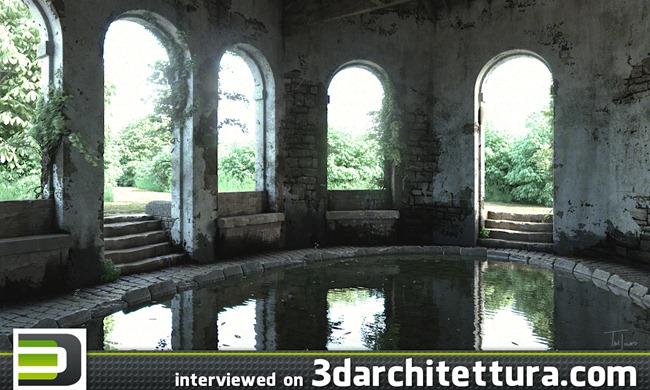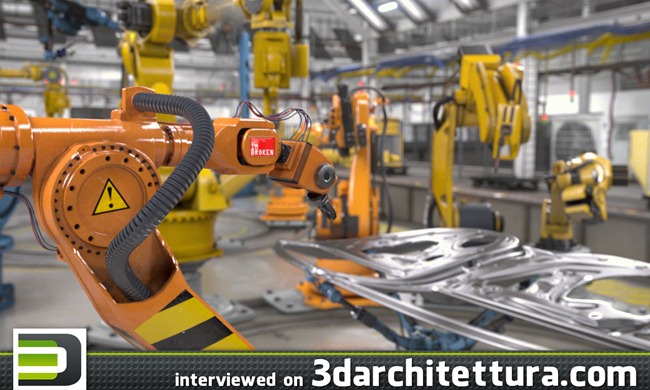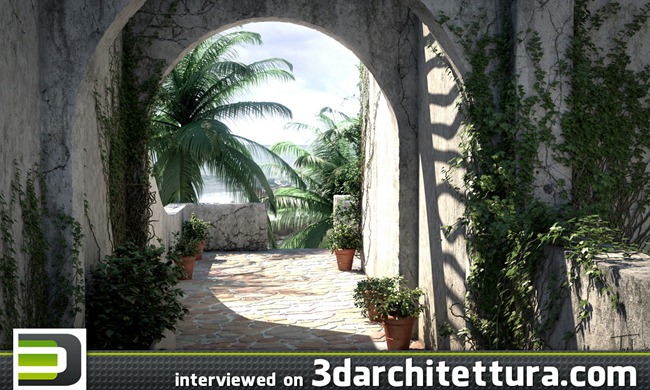Name: Tim Jones
Age: 33
Job: CG Supervisor @ Digital Domain
Country: USA
Website: www.seraph3d.com
3DA: How did you start working in 3D field? How much time passed and what kind of studies did you do?
TJ: I began learning CG back in 1998 while at college for an architecture degree. A good friend of mine showed me some professional architectural CG renders that a company he worked with had done. I was immediately interested in learning CG for myself and so I got myself a copy of Truespace 2 (which was the software used to create those architectural renders) and I began teaching myself and following tutorials online. I quickly discovered 3dsMax 2.5 and began learning it in my free time. Around this same time I was realizing that architecture was not really what I wanted to do anymore. I was in love with CG and wanted to pursue a job doing it. I finished my architecture degree since I was already halfway done with all the classes and decided to also go for a duel degree in illustration so that I could get a stronger art background. I set my sights on Blur Studio as the place I wanted to work. After graduating I moved to California and got a job doing architectural walkthrough animations. At night I would go home and continue to work on artwork for my demo reel. After a year I finally had a demo reel that was good enough and I was offered a job at Blur Studio. I was a CG supervisor there for 5 years. After that I decided I was wanting to move into the world of VFX and have been a CG supervisor at Digital Domain for the past 4 years.
3DA: Which are your favourite software and plugins for your daily projects?
TJ: At work I use Maya and Vray for rendering. At home (and sometime at work) I prefer to work with 3dsMax and Vray. I’m also very fond of Nuke and Mari which I use on nearly every project now. For 3dsMax I love working with Forest Pro. Other than that I don’t use very many plugins. I have written a bunch of maxscripts to help speed up my workflow though.
3DA: Tell us something about a project that gave you great satisfactions
TJ: I always get the most satisfaction from doing personal artwork. I use those projects to explore new ideas or workflows that I may not have time to try on a project at work. I’d have to say that my most recent personal project “Lavoir” has probably been the most satisfying project I’ve worked on for myself. As for my most satisfying project done at work I’d have to say being CG Sup and creating the environments and lighting for the first ever Bioshock announcement trailer at Blur. I also have fond memories of working on a Warhammer 40k cinematic while at Blur. The team created an entire cinematic from start to finish in just 3 weeks. It was a lot of long hours but everyone was so excited to be working on it and doing the best work they were capable of. In my time at DD I am especially happy with a project I CG sup’d as well as did modeling/lookdev/lighting on. It was a commercial for BMW featuring a CG KC-135 “stratotanker” airplane that refuels a bmw car while driving through the desert. Not only was the project subject fun, but it was also one of the smoothest projects I ever worked on. I also got to go out to an airplane museum and climb all over the real plane taking reference pictures and textures. I laid down in the boom operators station and was taught how to operate it by a guy who actually used to operate them in the air force.
3DA: From where do you take inspiration for your artworks?
TJ: Inspiration for me could come from anywhere really. I am often inspired by places I travel to, seeing others artwork, learning a new technique that may make an older idea possible/easier. I’m also inspired by the true stories and history surrounding real places.
3DA: How do you live this period of economic crisis? How is it in your country?
TJ: Things in the USA could certainly be better. I think its very unfortunate what is happening with all of the layoffs and studios going out of business. I’ve been fortunate so far and have managed to survive Digital Domain’s recent bankruptcy. I don’t see the demand for visual effects going away, so its a matter of getting all of the major players together and to agree on a new strategy for the future of the industry.
3DA: What would you suggest to people that are approaching to 3D and architecture?
TJ: The most important thing is to really love what you do. Being a visual effects artist is NOT a glamorous job and you will most likely be sacrificing a large portion of your life to working. At least as the state of the industry stands today that’s true. You must also not take your professional work to personally. The client is paying you to give them what they want, whether you like their ideas or not. You will be critiqued on a daily basis and there will be many times when your told your work is not good enough when you thought it looked good. Don’t take it personally, this is just how the business works. Go back and try again. Nothing is more important than loving what you do and being driven to improve your skills. There is a lot of competition out there and you have to constantly stay current with the latest workflows and technology.




























